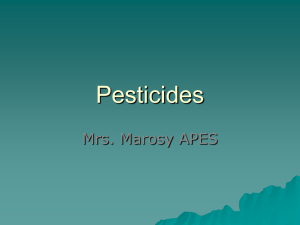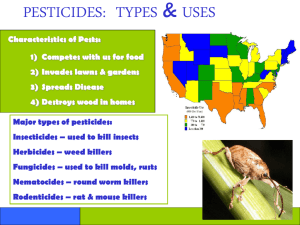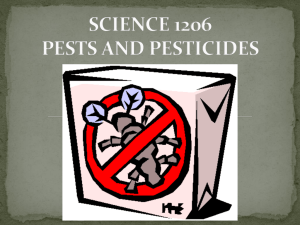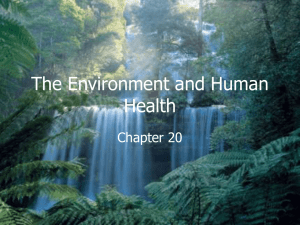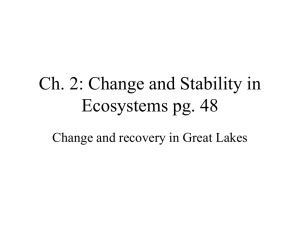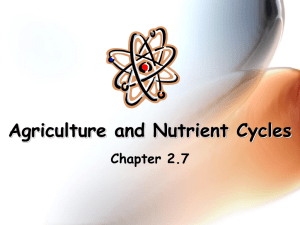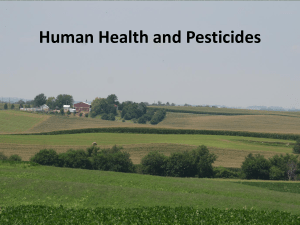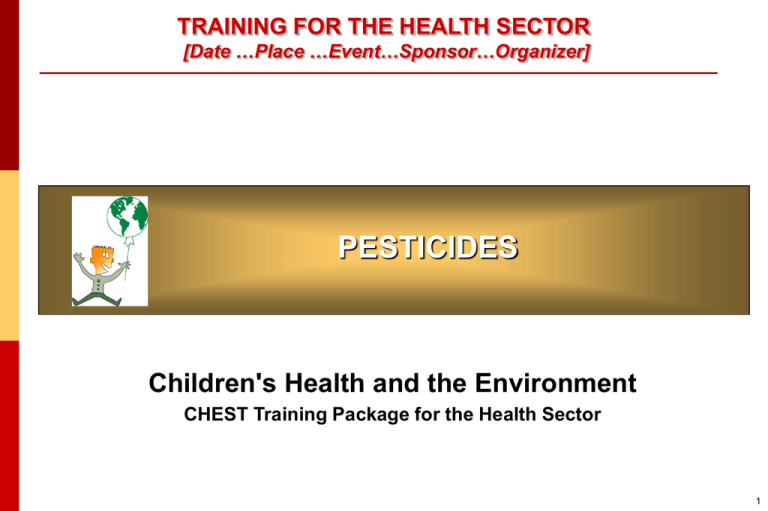
TRAINING FOR THE HEALTH SECTOR
[Date …Place …Event…Sponsor…Organizer]
PESTICIDES
Children's Health and the Environment
CHEST Training Package for the Health Sector
1
Pesticides and Children
LEARNING OBJECTIVES
Learn about pesticides – what they are and what are the
risks they may pose?
Identify the scenarios – where and when are children
exposed?
Recognize signs, symptoms and diseases that may be
related to pesticide exposure in children
Know how to prevent and treat children's pesticide
exposure
2
Pesticides and Children
OVERVIEW
Origin, environmental transport and fate of pesticides
Routes and circumstances of exposure
Toxicokinetics and toxicodynamics
Target organs and systems
Diagnosis and treatment of poisoning
Prevention of pesticide exposure and poisoning
3
Pesticides and Children
PESTICIDES – RISKS AND BENEFITS
BENEFICIAL EFFECTS
NEGATIVE EFFECTS
Toxic properties
Crop protection
Human
Food preservation
Environmental
Material preservation
Disease control
4
Pesticides and Children
USE OF PESTICIDES
Global Pesticide Use 1999
First synthetic pesticides:
1940
Consumption increasing
worldwide
herbicide
insecticide
fungicide
other
2.6 million tons of active
ingredients used in 1999
25% of the world production
www.epa.gov/oppbead1/pestsales/99pestsales/usage1999.html#3_1
used in developing countries...
where 99% of deaths due to
pesticides occur!
5
Pesticides and Children
USE OF PESTICIDES – TYPES OF PRODUCT
Pesticides used in different settings: - Agricultural
- Veterinary
- Domestic
- Institutional
Formulations:
liquid, gel, paste, powder, granules, pellets,
baits...
Concentrations: from 2% to 80% of active ingredient
Containers:
glass, plastic or metal flasks, bottles, drums,
plastic bags or paper bags....
6
Pesticides and Children
PESTICIDES – CLASSIFICATION BY USE
Chemicals designed to kill, reduce or repel pests: animals, plants, fungi...
Insecticides
Insect repellents
Herbicides
Fungicides
Rodenticides
Wood preservatives
Fumigants
7
Pesticides and Children
PESTICIDES – CLASSIFICATION BY USE
AND CHEMICAL STRUCTURE
Different chemicals used for different purposes
INSECTICIDES
•
•
•
•
Pyrethroids
Organophosphorus
Carbamates
Organochlorine
HERBICIDES
•
•
•
•
•
Bipyridyls
Chlorophenoxy
Glyphosate
Acetanilides
Triazines
FUNGICIDES
•
•
•
•
•
•
•
•
•
RODENTICIDES
Thiocarbamates
Dithiocarbamates
Cupric salts
Tiabendazoles
Triazoles
Dicarboximides
Dinitrophenoles
Organotin compounds
Miscellaneous
•
•
Warfarines
Indanodiones
FUMIGANTS
•
•
•
Aluminium and zinc
phosphide
Methyl bromide
Ethylene dibromide
INSECT REPELLENTS
•
Diethyltoluamide
8
Pesticides and Children
ORIGIN, TRANSPORT AND FATE
1.
Emission
2.
Drift
3.
Deposition
4.
Sedimentation
5.
Leaching
6.
Drainage
7.
Volatilization
Distribution routes and "receptor" organisms
for pesticides used in agriculture
Application
Humans
Wildlife
Plants
1
Spray
Granulate
Or
Seed
Treatment
Air
Target
Pest
6
- Crops
- Soil organisms
- Applicators
- Bystanders
- Wildlife
Terrestrial
organism
3
7
1
Soil
Cattle
Crops
Ground
water
5
2
Surface
water
Aquatic
organisms
4
Sediment
Sediment
organism
A .Laborde
9
Pesticides and Children
PERSISTENCE AND BIO-CONCENTRATION
PERSISTENT ORGANIC POLLUTANTS (POPs)
Persist in the environment
Accumulate in the food-chain
Lypophilic
Travel long distances
Concentrate in marine animals
May produce toxic effects
Organochlorine pesticides
PESTICIDES
Aldrin
Dieldrin
Chlordane
DDT
Endrin
Heptachlor
Mirex
Toxaphene
10
Pesticides and Children
PESTICIDES IN THE ATMOSPHERE AND WATER
USGS
11
Pesticides and Children
PESTICIDES IN THE ATMOSPHERE
USGS
12
Pesticides and Children
CHILDREN'S EXPOSURE
A cause of concern
Multiple chemicals
Multiple sources of exposure
Multiple routes of exposure
Multiple effects
WHO
13
Pesticides and Children
CHILDREN’S ENVIRONMENTAL EXPOSURE
Pesticides used in:
Children living on:
homes and schools, playgrounds,
parks, fields and other public places
farms, agricultural areas (rural setting)
Pesticides present in: air, soil, food, water, objects…
Different scenarios:
ACUTE
high-level exposure, overt poisoning
CHRONIC
low-level, chronic exposure, various effects
14
Pesticides and Children
SOURCES AND SETTINGS OF EXPOSURE...
HOME, SCHOOL, DAY-CARE, INSTITUTIONS...
Indoor and outdoor application
Mosquito control
Professional/domestic application
Lice or scabies
Fleas or ticks on pets
Pesticide residues
Dust, soil, furniture, carpets, toys, food…
Playgrounds, playing fields, lawns, gardens
Wood preservatives in play structures
Long range transport of POPs (e.g. DDT)
WHO
15
Pesticides and Children
SOURCES AND SETTINGS OF EXPOSURE
Children living on farms or in agricultural areas are exposed:
to pesticide drift from sprayed fields
to contaminated soil around living areas
to contaminated equipment and clothes
when playing around treated fields
while helping parents with spraying
… or with dips in animal husbandry
when working as child labour
Corra
16
Pesticides and Children
RURAL SETTINGS
Increase in the
levels of
organophosphorus
(OP)
metabolites
(DAP)
paralleling
pesticide
spraying in a
rural area
Koch EHP, 2002, 110 (8): 829
17
Pesticides and Children
PESTICIDES IN DIFFERENT MEDIA
Air
Respirable
particles contaminated with pesticides
Respirable aerosols during spraying
Vapour from volatile residues of pesticides
Soil
Hand-to-mouth
behaviour
Crawling on the ground
18
Pesticides and Children
PESTICIDES IN DIFFERENT MEDIA
Water
Pesticides in drinking-water: tap, well
Food
Crops routinely sprayed:
fruits, vegetables, grains
Bioaccumulation in animals and products
fish, meat, eggs, dairy
WHO
19
Pesticides and Children
PESTICIDES IN DIFFERENT MEDIA
Food residues
Many food products have detectable levels of pesticides
Guideline levels of pesticides in food (MRL)
Guidelines to limit the population exposure (ADI)
Acceptable daily intake (ADI)
Increasing concern about
cumulative dietary exposure
WHO
20
Pesticides and Children
EXAMPLE OF SEASONAL PESTICIDE USE
APPLE ORCHARD
CALENDAR
AUTUMN
Herbicides: simazine, paraquat, 2-4D
WINTER
Fungicides: dinitroorthocresol (DNOC)
Insecticides: organophosphates
SPRING
Fungicides: Cu salts, dithiocarbamates
Insecticides: endosulfan, OPs
NPS
SUMMER
Insecticides: OPs
Ref: Dr A. Laborde, Uruguay
21
Pesticides and Children
TOXICOKINETICS
Absorption
Distribution and storage
Dermal, ocular, ingestion,
Fat soluble pesticides are
inhalation, injection
stored in adipose tissue
Biotransformation
Into inactive or more
active metabolites
Elimination
Urinary excretion
Biliary / faecal excretion
Excretion in milk
22
Pesticides and Children
ROUTES OF EXPOSURE
Multiple/simultaneous routes of exposure
Ingestion
Breastfeeding
Accidental ingestion
Residues in food
Mouthing
Inhalation
Indoor and outdoor spraying
Occupational exposure
Dermal absorption
Transplacental
Accidental contact
Occupational exposure
Residues on surfaces
Contaminated clothing
Medical use: scabies, head lice
23
Pesticides and Children
ROUTES OF PERINATAL EXPOSURE
Mother’s intake and body burden is
transferred across the placenta
Breast milk may be contaminated
"The very top of the food-chain"
WHO
24
Pesticides and Children
METABOLIC PATHWAYS
Organophosphates
metabolize into:
oxon
DAP
Oxones
Specific inactive
metabolites (ME)
Non-specific
metabolites:
dialkylphosphates
(DAPs)
DAP
ME
Wessels, EHP (2003) 111 (16): 1939
25
Pesticides and Children
MECHANISMS OF ACUTE TOXICITY
Irritation (most of the pesticides)
Allergic sensitization (fungicides)
Enzyme inhibition (e.g. cholinesterases)
Oxidative damage (e.g. paraquat)
Inhibition of neurotransmission (e.g. organochlorines)
Calcium (Ca2+) homeostasis alteration
GABA inhibition
Uncoupling of oxidative phosphorylation (e.g. glyphosate)
26
Pesticides and Children
ACUTE PESTICIDE-RELATED ILLNESS
Dermal and ocular irritation (or allergic response)
Upper and lower respiratory tract irritation
Allergic responses / asthma (fungicides)
Gastrointestinal symptoms
Neurological symptoms
Specific syndromes
Cholinergic crisis (organophosphorus pesticides)
Bleeding (warfarin-based rodenticides)
Caustic lesions and pulmonary fibrosis
(herbicide, paraquat)
Pronczuk
27
Pesticides and Children
ACUTE POISONING
"Accidental" ingestion
Storage of left-over pesticide in a
medicine or soft-drink bottle
Confusion with pharmaceutical
Pesticide container re-used for
storing drinks or food
Pesticide container present in the
Bottles containing pharmaceuticals and
the pesticide chlorpyriphos
Laborde, CIAT, Montevideo
child's environment
28
Pesticides and Children
ACUTE POISONING
Arizona Household Survey
107 homes surveyed:
- 148 different pesticide products
- half were stored inside
- less than 1.2 m from ground
- in the kitchen
EPA
29
Pesticides and Children
DIAGNOSIS OF EXPOSURE
History of exposure
Availability of pesticides
Recent application
Signs and symptoms
May be misdiagnosed!
Laboratory tests
WHO
30
Pesticides and Children
ACUTE TOXINDROMES
PESTICIDE
Organo
phosphates
Clorpyriphos
Diazinon
Azinphos
Parathion
Carbamates
Carbaryl
Aldicarb
ACUTE
SYMPTOMS
Irreversible
cholinesterase
inhibition
DIAGNOSIS
TREATMENT
Cholinesterase
levels (red
blood cells)
- Supportive care
- Atropine i/v
- Oximes
- Decontamination
Cholinesterase
levels (RBC)
- Supportive care
- Atropine i/v
- Decontamination
Cholinergic crisis:
- nausea, vomiting
- hypersecretion
- miosis
- fasciculations
- coma
Reversible
cholinesterase
inhibition
31
Pesticides and Children
ACUTE TOXINDROMES
PESTICIDE
ACUTE
SYMPTOMS
DIAGNOSIS
TREATMENT
Type I
Allethrin
Permethrin
Tetrametrhin
- Tremor
- Ataxia
- Iritability
- Supportive care
- Symptomatic
- Decontamination
Type II
Deltamethrin
Cypermetrhin
Fenvalerate
- Salivation
- Temporary
paresthesias
- Seazures
Organo
chlorines
GABA blockade:
- Tremors
- Dizziness
- Seizures
urinary 3phenoxybenzoic
acid is measured
in research
studies
urinary 3phenoxybenzoic
acid is measured
in research
studies
- Detectable in
blood
Pyrethroids
Lindane
Endosulfan
- Supportive care
- Symptomatic
- Decontamination
- Supportive care
- Symptomatic
- Decontamination
32
Pesticides and Children
ACUTE PESTICIDE TOXINDROMES
PESTICIDE
ACUTE
SYMPTOMS
DIAGNOSIS TREATMENT
Chlorophenoxi
compounds
(e.g: 2,4 D)
Nausea, vomiting,
acidosis, mialgia
fever, miopathy,
neurophaty
Vomiting
Corrosive lesions
Hepatotoxicity
Acute tubular
necrosis
Pulmonar fibrosis
Haemorrhage
(from vit. K
antagonism)
Detectable in
urine
Decontamination and
Urine alkalinization
Dithionite test
in urine
Decontamination
Avoid O2
Hemoperfusion
Possibly:
corticosteroids and
ciclophosphamide
Vitamin K1
( fitomenadione)
Bipyridyl
compounds
paraquat
Anticoagulant
Rodenticide
Warfarine
Brodifacoum
Diphacinone
Elevated
Protrombine
Time (PT)
33
Pesticides and Children
LOW-LEVEL CHRONIC EXPOSURE
Growing body of epidemiological and animal data and research
studies suggest a link between long-term exposure and:
Abnormal growth and development
Impaired neurological development
Cancer
Increased susceptibility to infections
34
Pesticides and Children
PRECONCEPTIONAL PRENATAL EXPOSURE
Pesticide exposure before or during pregnancy
associated with increased risk of:
Infertility
Perinatal death
Spontaneous abortion
Premature birth
Fetal growth retardation
Congenital malformations
Early childhood cancer
WHO
35
Pesticides and Children
PRENATAL EXPOSURE AND
NEURODEVELOPMENTAL EFFECTS
Exposure during brain growth has subtle and
permanent effects on:
Brain structure and function
Neuronal and axonal differentiation
Serotoninergic system
Synaptogenesis
Programming of synaptic function
36
Pesticides and Children
PRENATAL EXPOSURE AND
NEURODEVELOPMENTAL EFFECTS
Mechanisms of developmental toxicity may be
different from those of acute toxicity
e.g.: Chlorpyrifos and cholinergic systems
Parent compound is also toxic
Non-cholinergic systems are primary targets too
37
Pesticides and Children
CHRONIC NEUROLOGICAL EFFECTS
Neurological sequelae of acute poisoning
Neurological symptoms due to high indoor
levels of pesticides
Subtle changes in memory and attention
38
Pesticides and Children
PESTICIDES AND CHILDHOOD CANCER
Some studies have found an association between
postnatal pesticide exposure and paediatric cancer
Brain tumours
Acute lymphocytic leukaemia
Non-Hodgkin lymphoma
39
Pesticides and Children
PRENATAL EXPOSURE AND CHILDHOOD CANCER
Maternal exposure to pesticide has been associated
with paediatric cancer – acute lymphocytic leukaemia
Association with parental occupational exposure
Leukaemia
Brain cancer
Hodgkin and non-Hodgkin lymphomas
Kidney cancer
40
Pesticides and Children
ENDOCRINE DISRUPTION
Low doses of certain pesticides may mimic or block
hormones or trigger inappropriate hormone activity
Endocrine disruption may alter development and
reproduction and induce birth defects
Infertility
Low sperm count
Early puberty
Hormone-dependent cancers (testicular, breast, prostate)
Altered sex ratio
41
Pesticides and Children
IMMUNOTOXICITY
Immunotoxicity is suspected, but evidence is limited
Studies in Arctic zone:
Higher incidence of ear infections
Cytokine panel abnormalities
www.smithsonianmag.si.edu/smithsonian/issues04/jan04/ima
ges/topdogs_mush_jpg.html
42
Pesticides and Children
PESTICIDES IN CHILDREN'S COMPLEX ENVIRONMENT
PESTICIDES
Agriculture
Veterinary
"Cosmetic"
Human health
Public health
Air, water, food, soil and objects
Eating and drinking contaminated food and beverages
Playing in contaminated areas
Reaching unsafely stored pesticides
House and farm help/child labour
SUSCEPTIBILITIES
Critical windows
Age
Nutritional status
Poverty
WHO
Home
School
Playground
Farms
Fields
Acute effects
Poisoning
Neurotoxicity
Impaired development
Endocrine disruption
Cancer
43
Pesticides and Children
PREVENTION OF EXPOSURE
What can be done to prevent pesticide exposure and
poisoning ?
Take action at
Local level
National level
International
WHO
44
Pesticides and Children
PREVENTION – LOCAL LEVEL
Use pesticides ONLY when the benefits outweigh the risks
Avoid cosmetic or scheduled use of pesticides in the home
Use integrated pest management (IPM), non-chemical pest controls
If pesticides are necessary:
Store in original containers with child-proof seals, out of reach, in a locked cabinet
Educate on the safe use of pesticides
Follow manufacturer’s instructions
Use protective equipment
Respect re-entry times
Pregnant women should not apply pesticides
Use least hazardous chemicals, least dangerous mode of application
45
Pesticides and Children
PREVENTION – COMMUNITY LEVEL
Integrated pest management (IPM)
Homes
Schools
Public buildings
Health centres
Public parks
Community activities
Community campaigns
School activities
Local awards or contests
Pesticide-free "zones"
Support organic farming
WHO
46
Pesticides and Children
PREVENTION – NATIONAL LEVEL
Education campaigns aimed at pesticide users, general
population and children
Restrict availability or limit use
Establish and monitor maximum residue limits
Surveillance and epidemiological vigilance for acute and
chronic related illness
Treatment capacities
Emergency services
Poison control centres
Education of health care providers
47
Pesticides and Children
PREVENTION – INTERNATIONAL LEVEL
Persistent organic pollutants (POPs)
Stockholm Convention
Hazardous chemicals and pesticides
Rotterdam Convention (PIC)
International organizations:
WHO, IFCS, FAO, ILO
Pronczuk
48
Pesticides and Children
PESTICIDES AND CHILDREN: ACTIVITIES IN WHO
1. Guidelines for the classification of pesticides by
2.
3.
4.
5.
hazard
Joint FAO/WHO Meeting on Pesticide Residues
International pesticide limits in water
Pesticides Databank on CD-ROM
Poison centres and pesticide exposures
49
Pesticides and Children
CRITICAL ROLE OF
HEALTH AND ENVIRONMENT PROFESSIONALS
Diagnose and treat
Publish, research
Sentinel cases
Community-based interventions
Educate
Patients and families
Colleagues and students
WHO
Advocate
Provide role model
50



